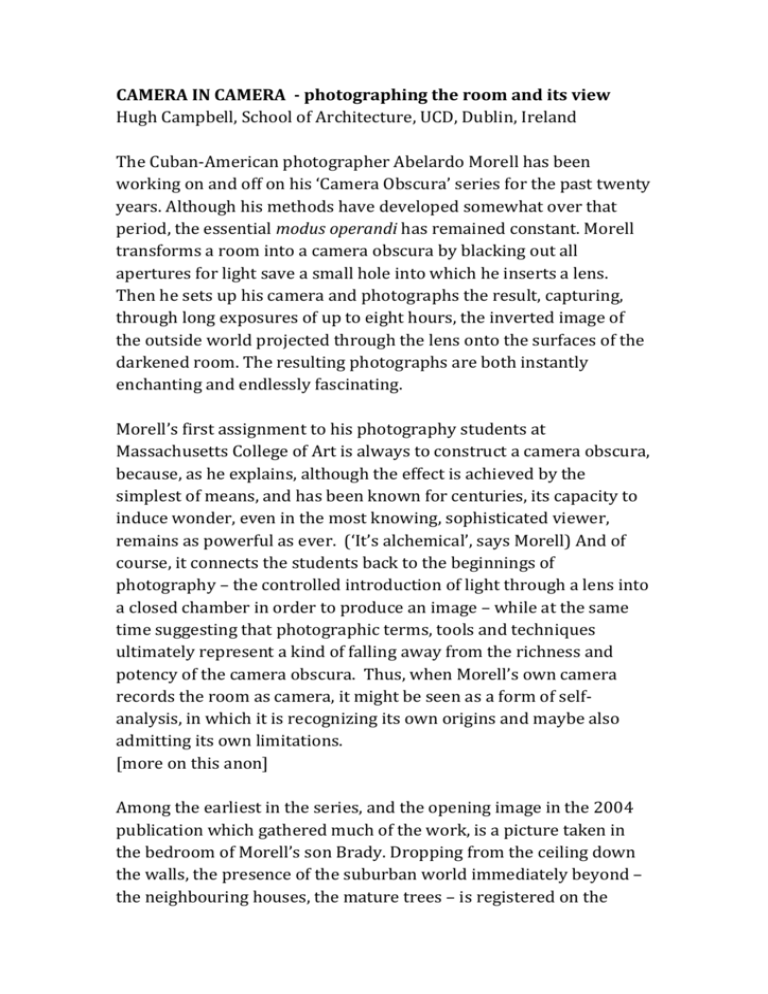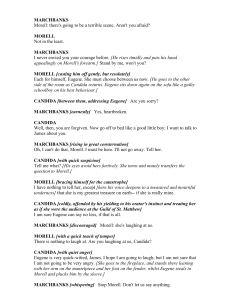final_paper_for_reading_buffalo_camera
advertisement

CAMERA IN CAMERA - photographing the room and its view Hugh Campbell, School of Architecture, UCD, Dublin, Ireland The Cuban-American photographer Abelardo Morell has been working on and off on his ‘Camera Obscura’ series for the past twenty years. Although his methods have developed somewhat over that period, the essential modus operandi has remained constant. Morell transforms a room into a camera obscura by blacking out all apertures for light save a small hole into which he inserts a lens. Then he sets up his camera and photographs the result, capturing, through long exposures of up to eight hours, the inverted image of the outside world projected through the lens onto the surfaces of the darkened room. The resulting photographs are both instantly enchanting and endlessly fascinating. Morell’s first assignment to his photography students at Massachusetts College of Art is always to construct a camera obscura, because, as he explains, although the effect is achieved by the simplest of means, and has been known for centuries, its capacity to induce wonder, even in the most knowing, sophisticated viewer, remains as powerful as ever. (‘It’s alchemical’, says Morell) And of course, it connects the students back to the beginnings of photography – the controlled introduction of light through a lens into a closed chamber in order to produce an image – while at the same time suggesting that photographic terms, tools and techniques ultimately represent a kind of falling away from the richness and potency of the camera obscura. Thus, when Morell’s own camera records the room as camera, it might be seen as a form of selfanalysis, in which it is recognizing its own origins and maybe also admitting its own limitations. [more on this anon] Among the earliest in the series, and the opening image in the 2004 publication which gathered much of the work, is a picture taken in the bedroom of Morell’s son Brady. Dropping from the ceiling down the walls, the presence of the suburban world immediately beyond – the neighbouring houses, the mature trees – is registered on the unassuming white surfaces of the room. The fact that this flood of visual data is inverted and seemingly uncontained contributes to its disorienting effect (the impact is lessened if the photo is viewed upside-down). Two realms, one private and fixed in dimensions, the other untrammeled and extensive are abruptly and comprehensively conjoined. To this might be added a third - the imaginary realm of play established by the dinosaurs and castle distributed across the floor of the room. The photograph suggests that rooms can always contain other worlds. Certainly Morell has spoken of the impact on his photographic practice of having a son. Watching the way in which he interacted with the world, and constructed worlds within his head made Morell, as he puts it, ‘look at things longer, with more love and tenderness’. Whereas previously his work had pursued ‘the decisive moment’, as proposed by Cartier-Bresson, now he became more interested in ‘longer looking’. ‘I started paying attention in a way I hadn’t done before’, he explains, ‘living with the things in front of me.’1 (To Brady – who made me want to play again, reads the book’s slightly corny dedication) Even as the photographs in the series become less tentative in their technique and more spectacular in their execution, even as the conjunction between interior and exterior becomes more extreme and dramatic, and even as a concern for formal composition becomes more pronounced, this underlying attentiveness to the given remains a constant. Morell also speaks of how these pictures represent for him a conscious ‘turn inwards, towards private experience’. Certainly these pictures seem concerned with states of consciousness, the overlay of one realm upon another, evoking states of dreaming or of distraction, demonstrating how the mind can be (perhaps always is) in two places at once. [think of Jane Eyre in her window seat, ‘shrined in double retirement’] And the preponderance of bedrooms among the photographs might lead us to believe, as Luc Sante expounds in his 1 http://www.lensculture.com/morell_interview.html introduction, that Morell has ‘taken his camera into the dream state and emerged with proof of what he saw there.’ But what I would like to suggest in this paper is that what is really being set forth here is a more fundamental affinity between what these pictures offer us - the room with its view folded back in upon it - and the experience of mind. The camera obscura has repeatedly been invoked as a metaphor to describe how the conscious subject perceives and experiences the world. As its use as an aid in painting became more widespread during the seventeenth and eighteenth centuries, so that parallel became more commonly asserted. John Locke, for instance, felt that human understanding was ‘not much unlike a closet wholly shut from light, with only some little opening left… to let in external visible resemblances, or some idea of things without.’ ‘[W]ould the pictures coming into such a dark room but stay there and lie so orderly as to be found upon occasion’, continued Locke, ‘it would very much resemble the understanding of a man.’2 Rene Descartes famously made extensive use of the camera obscura in his elaboration of the relationship between the res extensa (the world out there) and the res cogitans. He even provides instructions for making your own: ‘Taking the dead eye of a newly dead person (or failing that, the eye of an ox or some other large animal)….. cut away the three surrounding membranes at the back so as to expose a large part of the humor without spilling any…. No light must enter this room except what comes through this eye, all of whose parts you know to be entirely transparent. Having done this, if you look at the white sheet you will see there, not perhaps without pleasure or wonder, a picture representing in natural perspective all the objects outside.’3 Notwithstanding the visceral manner of its making, the camera obscura became for Descartes an abstracted, ideal figure, establishing a clear distance between sensation and its perception. For Richard Rorty, Descartes and Locke shared ‘the conception of the 2 3 Locke, An Essay concerning Human Understanding, II, xi, 17 René Descartes, The Philosophical Writings of Descartes, vol I, p.166 human mind as an inner space in which both pains and clear and distinct ideas passed in review before an Inner Eye… The novelty was the notion of a single inner space in which bodily and perceptual sensations… were objects of quasi-observation.’4 This inner space was where the self was constituted as a sovereign subject – its point of reference not the world at large, but the world as it appeared in what Locke termed ‘the mind’s presence-room’.5 (where the subject appears to its sovereign self, presumably) Even as it made that world available, the camera obscura affected a break between exterior and interior. For Jonathan Crary, in his extensive critique of this tendency, the camera ‘impels a kind of askesis, or withdrawal from the world, in order to regulate and purify one’s relation to the manifold contents of the now ‘exterior’ world. Thus the camera obscura is inseparable from a certain metaphysic of interiority: it is a figure for both the observer who is nominally a free sovereign individual and a privatized subject confined in a quasidomestic space.’6 Hence the camera became ‘a model simultaneously for the observation of empirical phenomena and for reflective introspection and self-observation.’ Crary offers Vermeer’s paintings of The Astronomer and The Geographer as exemplars of a kind of ideal equilibrium between these different species of interior – the outward- and the inward-directed. However he notes how the model can acquire ‘a more self-legislative and authoritative function: the camera obscura allows the subject to guarantee and police the correspondence between exterior world and interior representation and to exclude anything disorderly and unruly.’7 While it is not quite clear how this kind of editing might take place, it is nonetheless possible to understand how authority might be assumed over everything seen from the vantage point of the interior. One might alight upon examples such as the Studiolo at Urbino, in which the world at large is inscribed in marquetry upon the walls, Richard Rorty, Philosophy and the Mirror of Nature (Princeton, 1979) pp49-50 ref 6 Crary, Techniques of the Observer, p.39 7 ibid p… 4 5 perspectivally aligned to the viewpoint of the privileged occupant, or the Stanza de Segnatura in the Vatican in which the view to Bramante’s Cortile is echoed and augmented by the vistas opened up in Raphael’s frescoes. In both instances, drawn space and built space combine to make spatial and temporal expanses available to the governing eye: res cogitans meets res extans. Yet how closely does this kind of idealized viewing relationship, as adumbrated by Descartes and as achieved in such finely tuned spaces, actually accord with the altogether more giddying and disorienting experience of the camera obscura? Far from inducing sensations of calmness and equilibrium – of things being in balance – they seem rather to disrupt the perceived order, literally to turn things on their head. Turning back to Morell’s images, we find the commingling of the world outside and the world in here to be far less susceptible to easy analysis, hardly an emblem for rational thought. Following Locke’s desire, quoted earlier, that ‘the pictures coming into such a dark room [would] but stay there and lie so orderly’, in his text Crary interprets the camera as offering precisely that possibility, and therefore as the logical endpoint of the development of perspective vision- a kind of seeing in which everything keeps its distance (‘little Brunneleschi boxes’, the late Kirk Varnedoe called them). However in Morell’s images, distance is comprehensively breached. Vastness is overlaid directly upon intimacy with no regard for where it lands. Images imprint themselves upon the space. But the word ‘images’ does not feel appropriate – this is an impression of the world outside, in real and continuous time, being relayed within. It has not yet been framed and made available as an image. I might mention in passing here a line of enquiry which I did not get to pursue in this paper (although the conference abstract promised I would, so I will), which considers the fact that the camera struggles to record the room, which gave birth to it – equipped for distance, it struggles at close quarters, encountering distortions, pressing against limits. The camera wants to escape the room – to get to the view beyond it. In understanding the idea of things becoming images, it is useful to refer briefly to the pioneering work on perception of the psychologist J.J. Gibson, specifically to his notion of ‘ecological vision’. Gibson had a famously low regard for pictures, bemoaning ‘the chronic habit of civilized men of seeing the world as a picture’ which produced what he termed the Visual Field, a world of shifting formal and aesthetic abstract relations, as distinct from the known and invariant qualities of what he termed the Visual World.8 Borrowing these terms, in Morell’s pictures, we might feel we are seeing the visual world before it is rendered as a visual field, that we are seeing things before they become images and hence readily assimilable at a distance. And whereas it should be noted that for Gibson, it was in fact the non-image world that was the more stable, fixed and reliable, because it related directly to and answered human needs (providing what he termed ‘affordances’) in Morell’s pictures the visual content is less readily legible - it cannot be fully divorced from that which produces it and that which makes it visible – it remains imbricated in both. Hence, the curiously unresolved character of the images. We are seeing things in the act of becoming, or at least in the act of being reconstituted. Most often in Morell’s series, the settings pouring in to light the interiors are urban. A recurring trope finds a city panorama emblazoned on the walls and ceiling of a hotel bedroom. Of course we know the camera obscura’s long association with making available the grand urban view [Geddes’ Lookout tower etc], and in Crary’s account, this urge to encompass and possess the city is a natural extension of the device’s capacity to order and rationalize, but again these pictures speak of a different kind of relationship – not of ownership or command but of wonderment and awe on the one hand, or confusion and bewilderment on the other. The sheer 8 Gibson, The Visual Field and the Visual World, 1952, p149 profusion of visual data, it’s lack of frame or focal point prohibits comprehension: submission and surrender seem the only options. [ What a strange thing it is, we think, to walk into a static space and find it suddenly and completely animated by traces of the world just left behind. ] A useful point of reference here might be Boccioni’s well-known painting, The Street invades the House, which depicts a dynamic scene in which the vast, unknowable urban realm presses right up against, and indeed encroaches upon, the private chamber. This image was made at a period of tumultuous urban growth, its very ungovernability a source variously of anxiety or exhileration. For the Futurists it was more the latter than the former, and although it’s not entirely clear which of these the woman with her back to us is feeling, the relationship to the city is clearly of a different order than that presented by Gustave Caillebotte in his Man at a Window from forty years previously. The grand hotel was a product of this age of rapid urbanization and was often pressed into service as an emblem of the new urban relationships and identities being produced. Sigfried Kracauer famously described the Hotel Lobby as the modern antithesis of the temple, a place of anonymity and superficiality, betokening loss of identity.9 More recently, the hotel has been presented by Maureen Montgomery and Douglas Tallack among others as a female, quasidomestic space inscribed within the predominantly male world of the city.10 The focus of such interpretations is almost invariably the hotel’s lobby and reception rooms, but the same intimations both of anonymity and of private intimacy might equally be ascribed to the hotel bedroom.11 In fact, the bedroom might be seen as the ultimate locus of this ambiguous character – a space possessing all the trappings of domesticity – the bed, the soft furnishings, the low light Kracauer ref Douglas Tallack – New York Sights. Maureen Montgomery, Displaying Women: Spectacles of Leisure in Edith Wharton’s New York, Routledge 1998 11 Tom Avermaete and Anne Massey have just produced a new book on the modern hotel lobby, with almost no mention of the individual room 9 10 – but only ever transiently occupied. [ - think about how the hotel is meant to make you feel at home while away] Of course there are very practical reasons for which Morell has so often chosen hotel rooms as his location – they are hireable by the day, they guarantee privacy, they offer removal and elevation from one’s surroundings. But these same qualities all lend a deeper resonance to the resulting images. Implicit in the use of such private rooms is the suggestion that they house a single occupant or a single viewer. As other papers in this session demonstrate, the single room not only contains the single sovereign subject, it can stand as its equivalent... `One of the most renowned instances of this conflation of the confined room with the individual consciousness is Charlotte Perkins Gilman’s short story The Yellow Wallpaper, in which the protagonist’s fragile mental state finds its uncanny counterpart in the vivid wallpaper of the room in which she is locked. Gradually, the wallpaper begins to acquire lifelike qualities so that the very walls of the room appear animate. In closing, it is worth returning once again to the correlation between the camera obscura and conscious experience. The Cartesian view of the mind was dependent upon the idea that it was, in some sense, occupied – that there was a homunculus inside the mind interpreting all incoming data (what Daniel Dennett terms ‘the Central Meaner’). But in Morell’s photographs, the conscious subject is absent. The camera acts as a surrogate recording device. No individual volition or agency is necessary; nobody is bearing witness and yet witness is borne. (Morell himself does not remain in the room during what is typically an eight-hour exposure. He tried it once, he recalls, but found it a near-hallucinatory experience) What is portrayed is an automatic, recursive loop in which one camera sits inside another, seeing it in the act of seeing. This might be seen as a bleak, mechanistic view of subjectivity, but in fact it accords much more closely with more recent interpretations of consciousness, which see it as something endless, automatically produced rather than something rationally constructed. Recently, Thomas Metzinger has proposed what he calls the ‘phenomenal selfmodel’.12 Consciousness he argues, is the appearance of a world. The essence of the phenomenon of conscious experience is that a single and unified reality becomes present: if you are conscious, a world appears to you. Consciousness, for Metzinger, is a very special phenomenon, because it is part of the world and contains it at the same time.13 In other words, minds - like the rooms in Abelardo Morell’s photographs - encompass the worlds that encompass them. END A brief coda - if possible – the shift between objective and subjective image making – or the nonsense of these terms – and the play Thomas Metzinger, The Ego Tunnel: The Science of the Mind and the Myth of the Self, New York: Basic Books, 2009, p4 13 Metzinger 15 12









